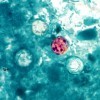Abstract
Cyclospora cayetanensis is a microscopic, spore-forming, intestinal protozoan parasite and a known cause of the gastrointestinal infection cyclosporiasis, often referred to as “traveler’s diarrhea” for its prevalence among visitors to regions where the species is endemic. These organisms have a protective covering that makes them resistant to disinfectants and that gives Cyclospora the ability to survive outside of hosts for extended periods. The incidence of cyclosporiasis has been increasing worldwide, with several documented cases in the United States and Canada. This revised 4-page fact sheet was written by Keith R. Schneider, Rachael Silverberg, Susie Richardson, and Renée Goodrich Schneider, and published by the UF Department of Food Science and Human Nutrition, March 2015. (Photo: CDC/DPDx – Melanie Moser)
FSHN0519/FS130: Preventing Foodborne Illness: Cyclosporiasis (ufl.edu)
References
Centers for Disease Control and Prevention (CDC). 2013. Notes from the field: Outbreaks of cyclosporiasis-United States, June-August 2013. Morbidity and Mortality Weekly Report 62:862-862.
Centers for Disease Control and Prevention (CDC). 2018a. Multistate Outbreak of Cyclosporiasis Linked to Fresh Express Salad Mix Sold at McDonald's Restaurants - United States, 2018a. Available at: https://www.cdc.gov/parasites/cyclosporiasis/outbreaks/2018/b-071318/index.html. Accessed on January 28, 2019.
Centers for Disease Control and Prevention (CDC). 2018b. Parasites - Cyclosporiasis (Cyclospora infection). Available at: https://www.cdc.gov/parasites/cyclosporiasis/index.html. Accessed on January 26, 2019.
Centers for Disease Control and Prevention (CDC). 2017. Traveler's health. Chapter 3; Infectious Diseases Related to Travel. Available at: https://wwwnc.cdc.gov/travel/yellowbook/2018/infectious-diseases-related-to-travel/cyclosporiasis. Accessed on January 28, 2019.
Chacín-Bonilla, L. 2010. Epidemiology of Cyclospora cayetanensis: A review focusing in endemic areas. Acta Tropica 115:181-193. https://doi.org/10.1016/j.actatropica.2010.04.001
Chacín-Bonilla, L. 2017. Cyclospora Cayetanensis. In: J.B. Rose and B. Jiménez-Cisneros, (eds) Global Water Pathogens Project. http://www.waterpathogens.org (J.S Meschke, and R. Girones (eds) Part 3 Viruses) http://www.waterpathogens.org/book/cyclospora-cayetanensis Michigan State University, E. Lansing, MI, UNESCO.
Eberhard, M. L., E. K. Nace, and A. R. Freeman. 1999. Survey for Cyclospora cayetanensis in domestic animals in an endemic area in Haiti. The Journal of Parasitology 85:562. https://doi.org/10.2307/3285797
Hall, R.L., J.L. Jones, and B.L. Herwaldt. 2011. Surveillance for laboratory-confirmed sporadic cases of cyclosporiasis-United States, 1997-2008. Morbidity and Mortality Weekly Report. 60:1-13.
Mansfield, L.S. and A.A. Gajadhar. 2004. Cyclospora cayetanensis, a food-and waterborne coccidian parasite. Veterinary Parasitology 126:73-90. https://doi.org/10.1016/j.vetpar.2004.09.011
Ortega, Y.R., and L. J. Robertson. 2017. Cyclospora cayetanensis as a foodborne pathogen. Springer, Cham. https://doi.org/10.1007/978-3-319-53587-6
Ortega, Y.R. and R. Sanchez. 2010. Update on Cyclospora cayetanensis, a food-borne and waterborne parasite. Clinical Microbiology Reviews 23:218-234. https://doi.org/10.1128/CMR.00026-09
Torres-Slimming, P.A., C.C. Mundaca, M. Moran, J. Quispe, O. Colina, D.J. Bacon, A.G. Lescano, R.H. Gilman, and D.L. Blazes. 2006. Outbreak of cyclosporiasis at a naval base in Lima, Perú. The American Journal of Tropical Medicine and Hygiene 75:546-548. https://doi.org/10.4269/ajtmh.2006.75.546
Turgay, N., A. Yolasigmaz, D. D. Erodogan, F.Y. Zeyrek, and A. Uner. 2007. Incidence of cyclosporiasis in patients with gastrointestinal symptoms in western Turkey. Medical Science Monitor 13:CR34-CR39.
U.S. Food & Drug Administration (FDA). 2018. Division of foodborne pathogens. Fact sheet: Cyclospora. Available at: https://www.fda.gov/Food/FoodborneIllnessContaminants/Pathogens/ucm610936.htm#Cyclosporiasis. Accessed on January 28, 2019.

